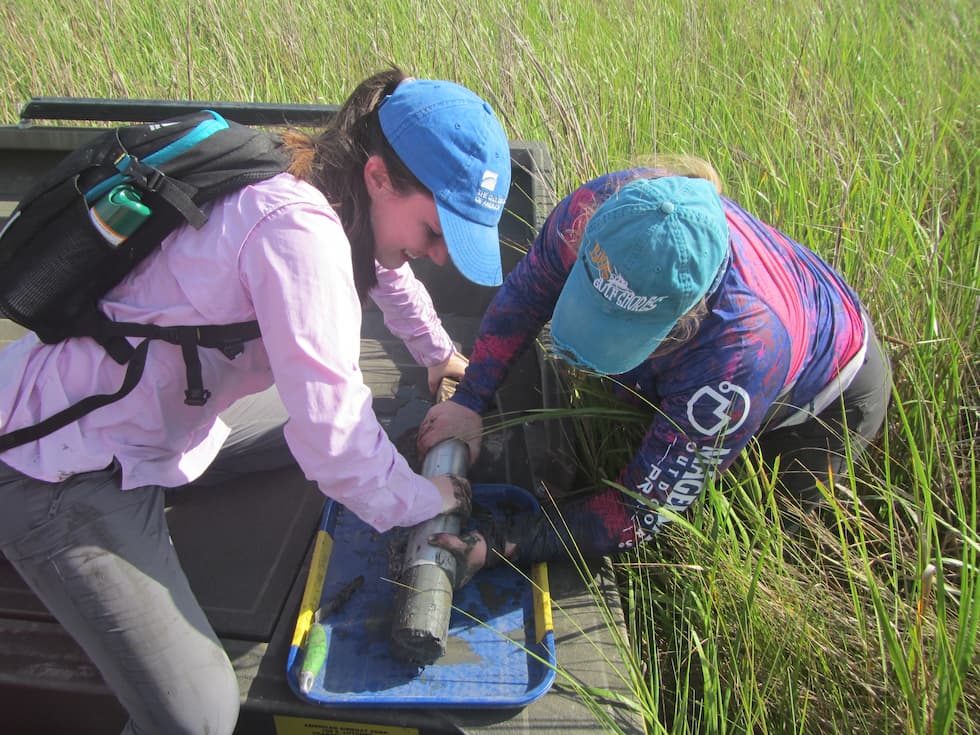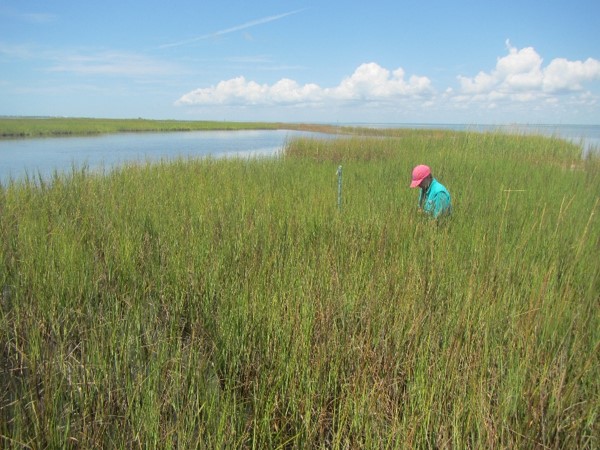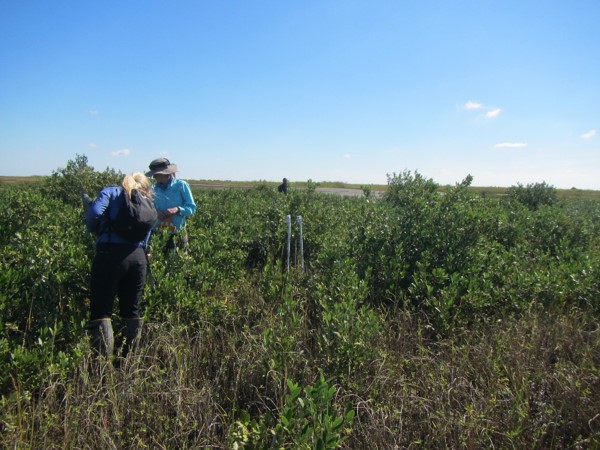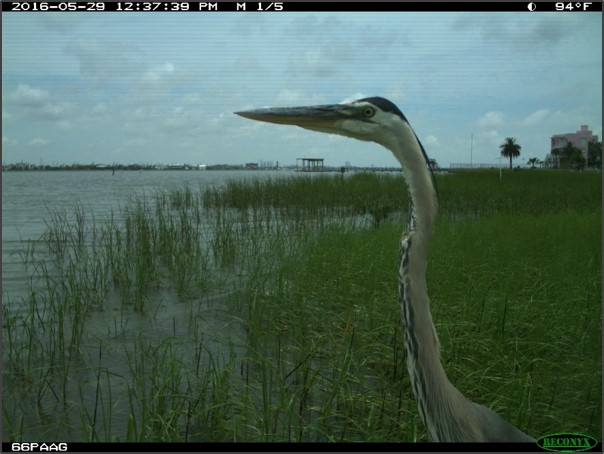Research Projects
Our current research evaluates the influence of habitat restoration, nutrient enrichment, climate change, and other anthropogenic disturbances on coastal wetlands, mangroves, and subtidal seagrass beds. Current projects include:
How effective is dredge material at restoring foraging habitats for coastal birds?
Coastal wetland restoration projects often employ beneficial uses techniques that place dredge material in degraded areas. Frequently, plant coverage increases quickly in these areas, but this outcome is not always directly related to boosting the ecological value of the habitat for coastal birds. Birds select foraging habitat based on the presence and accessibility of food, so the value of these restored areas as bird habitat is likely to be closely linked to the abundance of swimming, crawling, and burrowing invertebrate animals (nekton, benthic fauna and infauna) that colonize the new sediments. This ongoing project seeks to assess the trophic value of beneficial uses restoration sites for wetland-dependent birds.

Extraction of a core for infaunal sampling.
In Phase 1 (2022), we collected infaunal cores from restored sites created in 2013 and 2020 and from reference areas in the Salt Bayou ecosystem in the J.D. Murphree Wildlife Management Area on the upper Texas coast. In general, the highest abundances of infauna were found in older sites or reference areas, though infaunal abundance was highly variable over space and time. In addition, infaunal community composition was similar across all restoration and reference areas. Thus, the restored sites do appear to provide potential trophic support for coastal birds. However, the value of these restored sites for coastal birds is likely to change over time. Comparisons to surveys conducted in 2014 indicated that the older restored sites had become heavily vegetated since construction, and that there was less suitable tidal flat and pond habitat for foraging shorebirds at these older sites. Thus, the absolute area available for foraging, and the total number of birds utilizing older restored sites was lower, despite higher infaunal abundance. These findings demonstrate that the inclusion of persistent nonvegetated features, such as tidal flats and ponds, will support sustained coastal bird use of restoration sites.
In Phase 2 (2025), we will conduct a series of surveys to assess additional food sources for birds, including benthic microalgae and infauna. We will also conduct a series of field experiments to assess bird consumption of infauna and microalgae in restored areas.
This project is done in cooperation with the Texas Parks and Wildlife Department and is funded by the Texas General Land Office – Coastal Management Program.
Restoring coastal wetlands for shorebirds: leveraging lessons learned to identify research priorities and strategies to maximize future success
Shorebird use of restored wetland habitat for foraging or roosting is closely linked to fine-scale elevation features, such as the inclusion of shallow pools for foraging in site design. Integrating small-scale elevation heterogeneity into restoration site design may enhance shorebird use, without diminishing broader success criteria for vegetation cover. These elevation features are context- and species- dependent, and effective restoration projects must have local data to inform the appropriate elevation profile for the site. Thus, the central natural resource management question addressed in this project is: How can elevation profiles of beneficial uses restoration projects be designed to enhance shorebird habitat? The Salt Bayou ecosystem on the upper Texas coast is an ideal focal ecosystem for this project, as it encompasses numerous past, current, and potential future wetland restoration projects. New beneficial uses (BU) projects planned over the next five years will employ elevation profiles based on the outcomes of this project. The project team will (1) leverage past research by synthesizing lessons learned from past projects, and (2) develop a blueprint to guide future research directions and boost the success of future investments.
This research is funded by the NOAA RESTORE Science Program.
Understanding ecosystem responses to the closure of Rollover Pass on Bolivar Peninsula
The Rollover Pass channel was an artificial strait through the Bolivar Peninsula that linked the Gulf of Mexico to Rollover Bay and East Bay in eastern Galveston County. Rollover Pass was originally opened by the Texas Game and Fish Commission in 1954 to increase bay water salinity, promote growth of submerged vegetation, and provide access for marine fish to and from spawning and feeding areas in East Bay. Although Rollover Pass was a popular location for recreational fishing, its benefits were not universal. The Pass contributed to accelerating erosion that diverted sediments and caused land loss in the adjacent beach areas of Bolivar Peninsula. The presence of the Pass may have contributed to damage that adjacent residential and commercial developments suffered during Hurricanes Carla in 1966 and Ike in 2008. Further, the historically freshwater emergent marsh habitat on the north and south shores of East Bay became more brackish after the Pass was opened, leading to loss of emergent and submerged aquatic vegetation and a shift towards more marine nekton and benthic faunal species.
Although not without controversy, Rollover Pass was closed in late 2019. Our research explored the near term ecosystem responses within East Bay to the closure of Rollover Pass. Near the Pass, water salinity decreased modestly, and became less variable over time. In the marshes, the plant communities changed over time, but the types of species present remained the same. There was no clear shift towards species characteristic of freshwater marshes. Likewise, all of the fish and invertebrate species present were salt tolerant. Submerged aquatic vegetation was sparse at all sites. Overall, these data indicate that ecosystem responses to the closure of Rollover Pass are occurring gradually, and any additional changes may occur gradually over the coming years.
This research is funded by the Texas General Land Office – Coastal Management Program.
Do mangroves provide better coastal protection than salt marshes? A Hurricane Harvey case study
On the Texas coast, black mangroves are becoming more common, often displacing salt marshes. Dr. Anna Armitage (Professor, Marine Biology, TAMUG) and her colleagues, Dr. Steve Pennings (University of Houston) and Dr. John Kominoski (Florida International University) have been studying the ecological consequences of this mangrove expansion in our region. Hurricane Harvey provided a unique opportunity to answer a critical question: do mangroves provide fundamentally different – or better – shoreline protection than the grasses and shrubs that they replace? Mangroves are often assumed to be more resilient to erosion and to be better able to protect shorelines, relative to stands of marsh plants, but this has not been tested in our region, where the mangroves tend to be relatively small.
Hurricane Harvey made landfall as a Category 4 storm very close to Armitage’s mangrove and marsh study plots near Port Aransas, Texas. This event provided her research team with an unexpected and unprecedented opportunity to study the immediate impacts of mangrove expansion on shoreline protection and other vital ecosystem services. Armitage and her colleagues will examine hurricane effects on erosion, plant mortality, damage, and recovery, and soil quality in a series of mangrove and marsh study plots. The information from this study will be extremely valuable to coastal managers responsible for restoration and management projects along shorelines vulnerable to future hurricanes. This project is funded by the National Science Foundation RAPID program through September 2018.
Mangrove Restoration in Galveston Bay: Ecological Benefits and Effective Restoration Techniques
The objective of this project is to determine if, where, and how mangrove restoration should be implemented in Galveston Bay. In order to yield successful results, coastal wetland restoration strategies need to be adapted to the rapidly-changing coastal landscape. Our goal was to inform best-practices for mangrove (Avicennia germinans) restoration, and to provide recommendations as to if and when coastal wetland restoration efforts should include mangrove plantings.
Restoration practice. In general, few of the planted mangroves at restoration sites were thriving. Most of the planted shrubs remained small (less than 1 m) for several years after planting, though many were reproductive. The healthiest mangroves were usually at relatively high elevations, near the upper edge of the Spartina alterniflora zone. Mangroves are actively recruiting to this high elevation zone at numerous locations around Galveston Bay, independent of planting efforts.
Ecological benefits of mangroves. Marsh plant diversity was lower at sites with high mangrove cover. Within marsh or mangrove stands, fish and invertebrate densities were generally similar, though the species composition differed. Stable isotope analysis indicates that marsh vegetation is more important than mangroves in supporting coastal wetland food webs. At low densities, mangroves did not substantially alter wading bird or shorebird abundances. Mangroves generally increased carbon retention in the soil. Overall, our results revealed that salt marshes and mangroves support different plant and animal assemblages, and that mangrove encroachment is likely to cause complex changes in ecosystem processes.
This project was funded through grants from the Texas Commission on Environmental Quality and the U.S. Environmental Protection Agency.

Surveying fauna in a restored marsh.

Measuring tagged trees in a mature mangrove stand.

Game camera capture of a great blue heron at a restored mangrove site.
Ecosystem restoration: ecological restoration of emergent coastal marshes and aquatic habitats
As our understanding of complex biotic and abiotic links between emergent marshes and adjacent aquatic habitats increases, restoration approaches must also increase in complexity. The development of plant canopy features is often considered to be a sign of successful coastal marsh restoration, but a robust plant canopy may not correspond with the recovery of other ecosystem attributes such as nutrient retention or energy flow through food webs. Furthermore, construction designs that incorporate different soil sources and elevation gradients can also influence the ecosystem characteristics of a restored marsh. Therefore, we are performing a series of monitoring and experimental series in order to understand patterns of ecosystem attribute recovery in restored coastal wetlands. Since 2009, we have been comparing the success of several emergent marsh restoration techniques by monitoring plant and animal assemblages in restored brackish marshes near Port Arthur, Texas. We are also conducting a number of experiments to understand how interactions between plants and herbivores are influenced by marsh restoration methods. An exceptional drought in 2011 provided us with the opportunity to examine how drought affected the development and recovery of these restored marshes. This research has been supported by the Texas General Land Office – Oil Spill Prevention & Response Division of Research and Development and Scientific Support and by the Texas General Land Office – Coastal Management Program.
Changing coastal ecosystems: causes and consequences of mangrove expansion into northern Gulf of Mexico salt marshes
On the Texas coast, black mangroves (Avicennia germinans) regularly expand from persistent populations into salt marshes during periods with warm winters, and occasionally contract in distribution during periods with severe freezes. Over the coming decades, mangrove distributions are expected to continue expanding due to rising global temperatures and milder winters. As a result, large areas of the Texas coast that historically have been dominated by salt marshes will become dominated by mangroves. Will this matter? In a collaborative project with Dr. Steven Pennings (University of Houston), we hypothesize that that changes in coastal vegetation are likely to change the quality of coastal wetlands for supporting shrimp, fish and birds, and change the ability of coastal habitats to buffer wind and wave energy. We will test these hypotheses using a combination of field sampling and a manipulative experiment, working around and within the domain of the Mission-Aransas National Estuarine Research Reserve. Our work will provide information on which ecosystem services provided by coastal wetlands are most likely to be affected by the change from salt marsh to mangroves. This information will allow coastal industries such as fisheries and tourism to be adaptively managed in response to ongoing and future changes in the biological environment. This project has been funded by Texas Sea Grant.
Click here to visit the Mangroves in Texas website.
Blue carbon in coastal wetlands: the effects of restoration and woody encroachment
Carbon can be absorbed from the atmosphere and stored by microbial and plant communities in a process called sequestration. A portion of this carbon is respired by the plants and released back into the atmosphere, but the remainder is converted into biomass that may become sequestered in the soil for decades. Carbon that is sequestered in marine habitats such as marshes, mangroves, and seagrasses, is known as “blue carbon.” The carbon sequestration role of coastal habitats is likely to be of paramount importance in the maintenance of global atmospheric carbon levels, but the burgeoning field of blue carbon still lacks quantitative estimates of carbon storage in many marine habitats. Therefore, our research in this area addresses two general questions: (1) How does carbon storage in restored coastal wetlands compare to reference wetlands? (2) How does the encroachment of mangroves into salt marshes change the carbon storage potential of the ecosystem? To address these questions, we are working with collaborators to integrate remote sensing with biogeochemical and biological estimates of carbon flux and storage on the Texas coast. This research has been funded by the Texas General Land Office – Coastal Management Program, the NASA Carbon Cycle Science Program, and Restore America’s Estuaries.
